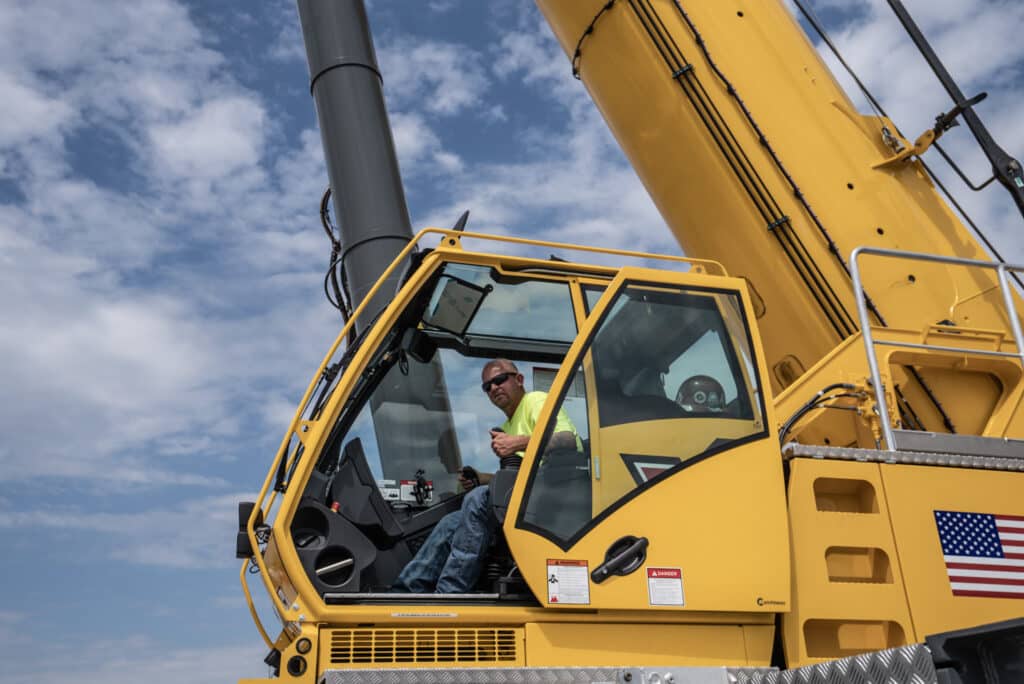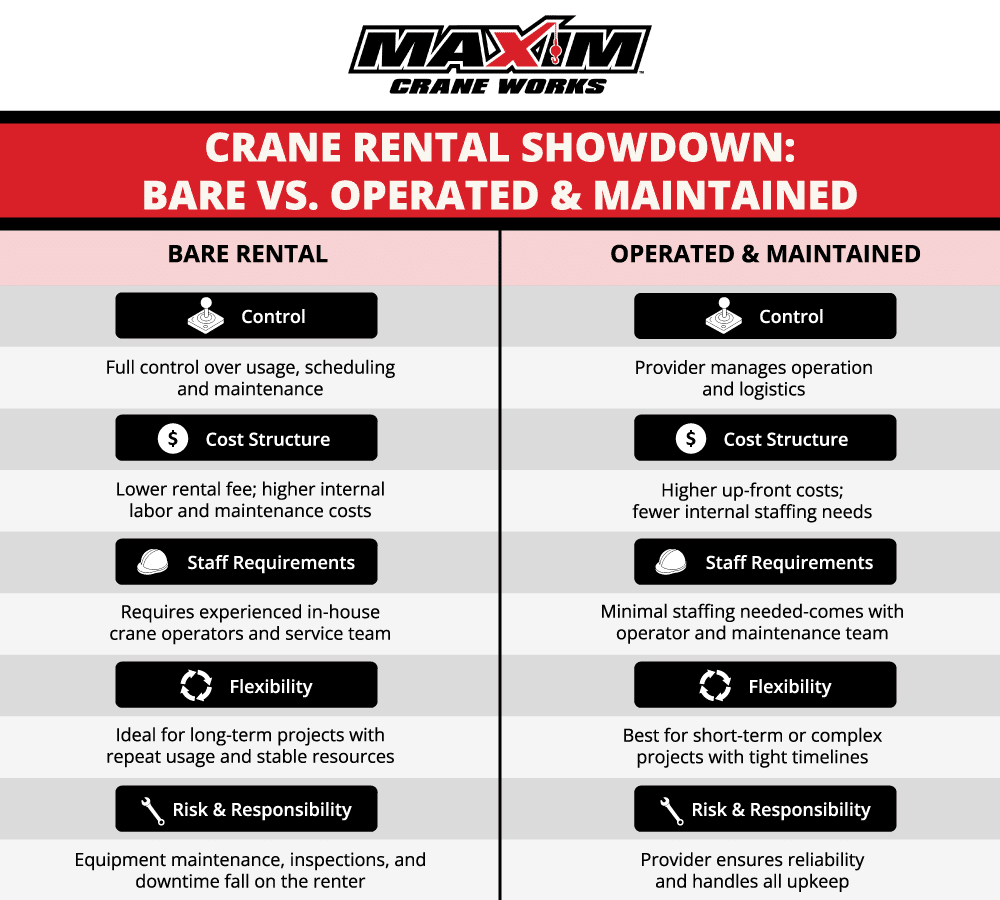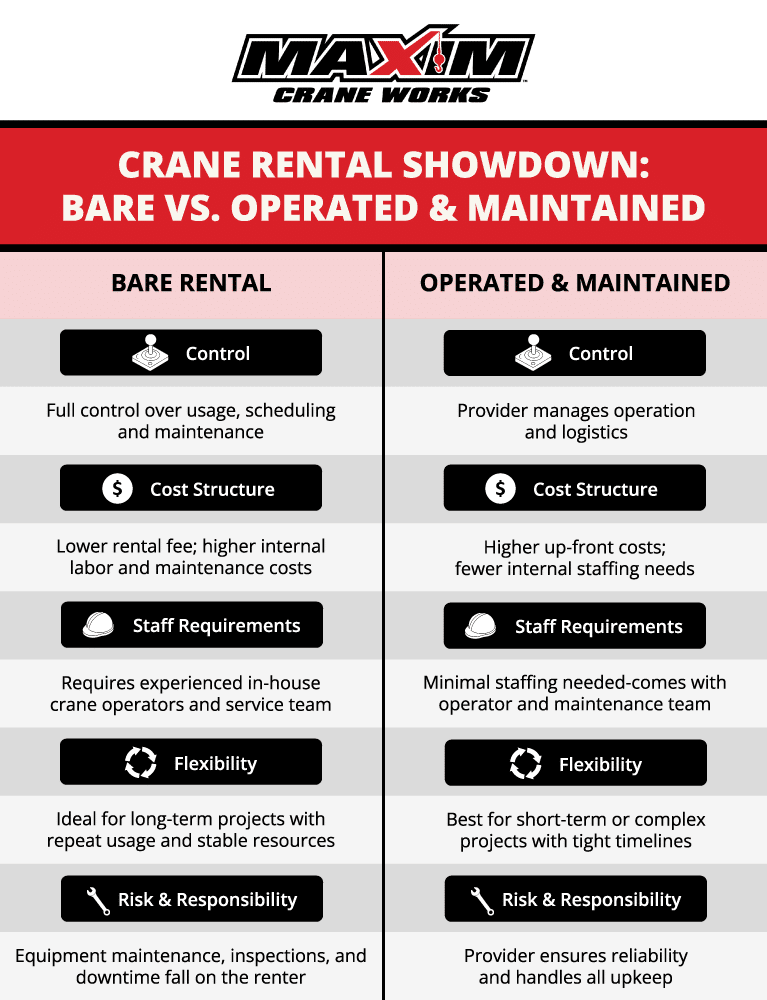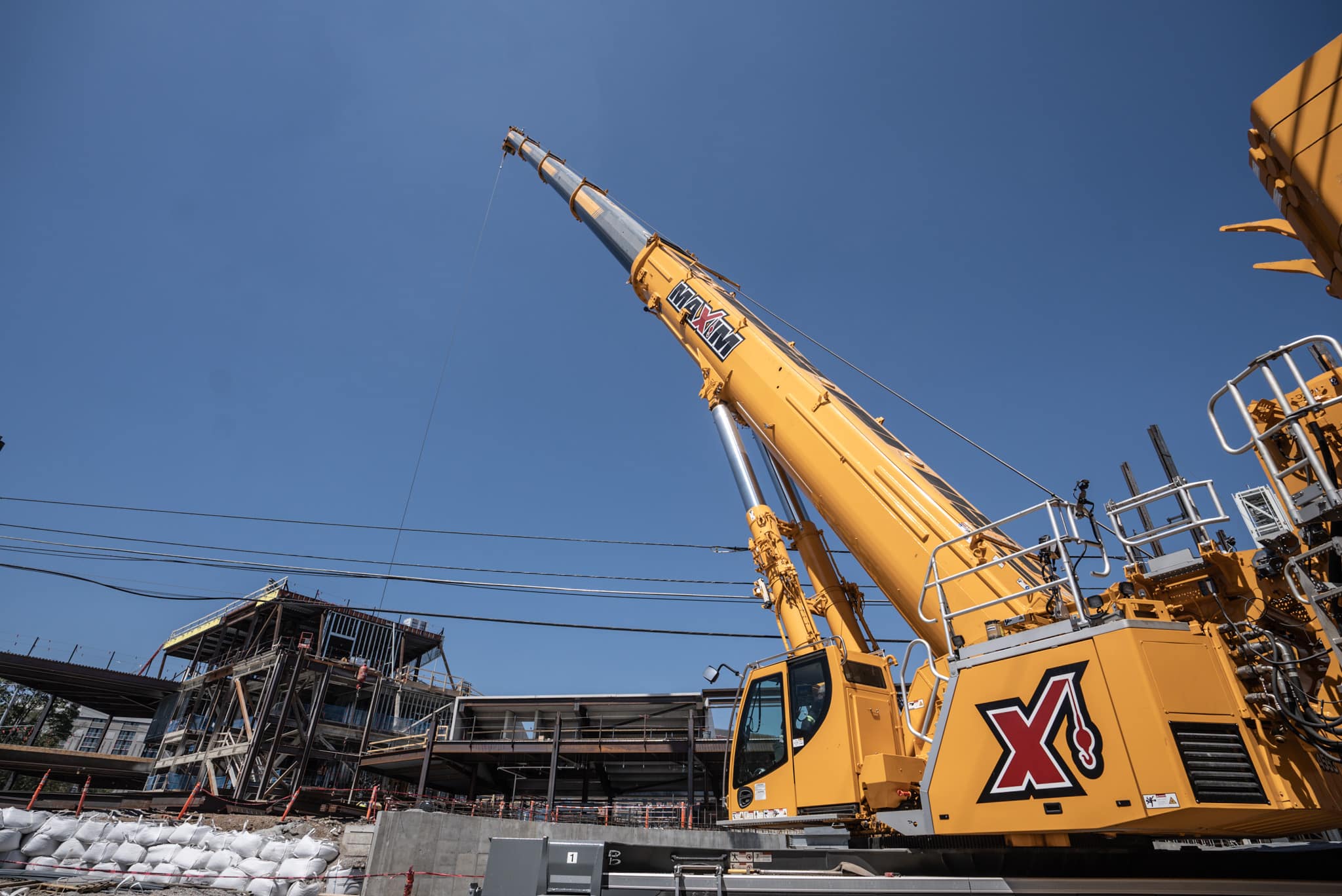When it comes to large-scale construction, industrial ventures, or infrastructure initiatives, heavy lifting solutions are pivotal. Renting a crane often emerges as a practical and cost-effective way to tackle these needs. The right crane rental option helps you manage your budget and schedules while enhancing project efficiency.
Two of the most common crane rental models are bare crane rental and operated & maintained crane rental. Each offers distinct features, benefits, and considerations, making them better suited to specific project circumstances. Whether you prioritize flexibility, cost-effectiveness, or convenience, understanding these options helps you make a well-informed choice that aligns with your project’s demands.
This article explores both crane rental options in detail, highlighting their advantages, considerations, and ideal use cases to guide your decision-making process with confidence.
Introduction to Bare and Operated & Maintained Crane Rentals
Choosing the right crane rental option is a crucial decision for construction, industrial, and infrastructure projects. Both bare crane rental and operated & maintained rental provide access to various high-capacity cranes but differ in terms of cost, service scope, and the level of oversight you maintain.
Renting a crane provides several key advantages, including:
- Grant access to specialized equipment without long-term ownership commitments.
- Help manage capital expenditures by removing sizable upfront investments.
- Offer flexibility to scale equipment usage according to changing project needs.
By evaluating factors such as internal capabilities, budget, and operational preferences, businesses can align their rental choice with project goals while promoting smooth and efficient progress.
Let’s look closer at the two primary types of crane rental options to understand their respective benefits and potential trade-offs.
What Is Bare Crane Rental?
Bare crane rental involves leasing a crane without built-in assistance for day-to-day usage or upkeep. In this arrangement, the renter takes on responsibilities tied to equipment management and any related tasks. It is well-suited for teams experienced with heavy machinery and capable of providing the logistical support necessary to keep the crane in service.
Under a bare crane rental contract, the provider delivers the equipment to the project site, but subsequent duties—such as scheduling, daily usage, and repairs—lie with the renter. This approach can be especially advantageous for organizations that already have knowledgeable personnel and solid internal processes to handle specialized machinery. By leveraging existing resources, companies gain greater control over scheduling and maintenance, which can translate into cost savings over extended or recurring projects.
Benefits of Bare Crane Rental
Bare crane rental can be advantageous when you have the capacity and expertise to manage equipment on your own. Its primary benefits include:
- Cost Focus on Equipment: If your business already has an internal team familiar with heavy equipment, bare rental allows you to concentrate spending on the crane itself. Reducing or eliminating external service fees can be budget-friendly, particularly for ongoing or repeat lifting tasks.
- Autonomy and Schedule Control: Bare rentals provide full control over usage and maintenance, allowing adjustments and modifications to fit your project’s evolving demands. This freedom can help organizations adapt quickly to tight deadlines or changing work scopes.
- Tailored Approach for Experienced Staff: Businesses with seasoned in-house resources may customize crane usage to align with unique project needs. From selecting configurations to planning daily tasks, you maintain direct control over every aspect.
Challenges and Considerations for Bare Crane Rental
Although bare crane rental offers autonomy and potential cost savings, it also includes responsibilities that demand careful thought:
- Maintenance and Repair Responsibilities: The renter handles equipment upkeep, which can mean routine inspections, part replacements, and general servicing. If you do not have dedicated internal resources or a reliable plan, these tasks might lead to unexpected downtime.
- Staffing Requirements: An internal team with experience in specialized machinery is essential for smooth crane operations. Insufficient expertise can add time and expense to project execution.
- Scheduling Overlaps: Delays in planning or performing regular maintenance can disrupt your timeline. Having a clear strategy helps keep your project on track.
Bare crane rental can be a strategic option for those with robust in-house capabilities. However, it demands thorough preparation for internal management, including documentation, scheduling, and equipment know-how.
What Is Operated & Maintained Crane Rental?

Operated & maintained crane rental takes a more comprehensive approach, with the crane provided alongside a service package that covers usage oversight and upkeep. This model can be especially beneficial if your internal resources are stretched, or when a highly coordinated lifting plan is required.
Rather than focusing on daily tasks yourself, you benefit from a provider that handles crane-related activities and ongoing care. This streamlined method often proves convenient for short-term projects or complex lifting scenarios by reducing administrative burdens. Though the up-front costs may be higher, the payoff is found in simplified operations, more predictable workflows, and less internal workload.
Advantages of Operated & Maintained Crane Rental
An operated & maintained rental creates a turnkey setup that can streamline demanding lifting tasks. Key advantages include:
- Full-Service Support: Instead of dedicating an internal team to daily usage and coordination, you gain assistance that fosters efficient equipment performance. This can be particularly practical for large-scale or intricate jobs.
- Reduced Day-to-Day Upkeep: The provider handles maintenance activities, minimizing downtime and supporting flexible scheduling. This simplifies management, especially under tight deadlines.
- A True Turnkey Approach: For projects requiring a complete, hands-off plan, an operated & maintained model offers start-to-finish coverage. This type of agreement can be particularly valuable on complex or shorter-duration initiatives where consistent oversight is critical.
While operated & maintained rentals shift many burdens to the provider, it is important to weigh their higher cost against the advantages of less administrative coordination and fewer unplanned interruptions.
Advantages and Trade-Offs: Making the Right Choice
Choosing between a bare crane rental and an operated & maintained rental often hinges on the goals of your project, its duration, and the resources available. Below are some considerations that may guide your decision:
1. Financial Considerations
- Bare Rental: Typically features lower direct expenses if your team can handle management tasks. Structural costs for staffing and maintenance can accumulate over time, so evaluate your project length and how frequently you’ll need the crane.
- Operated & Maintained Rental: Generally comes with a higher price tag, but it may be more cost-effective for shorter assignments or projects requiring specialized support. This model can also help you avoid unanticipated expenses associated with maintenance and/or downtime.
2. Control vs. Convenience
- Bare Rental: Offers complete oversight of the equipment, which is advantageous if you prefer to handle scheduling and logistics directly.
- Operated & Maintained Rental: Relieves your internal team from day-to-day responsibilities while slightly reducing your direct control. For many projects, the resource savings outweigh any loss of oversight, especially when efficiency is paramount.
3. Project Duration and Complexity
- Bare Rental: May offer cost savings for more extended projects or those requiring recurring crane usage. This can be advantageous for experienced teams with established internal processes and resources.
- Operated & Maintained Rental: May be more appropriate for shorter, complex, or specialized projects. This model can simplify the management of intricate equipment, particularly when your business does not have the internal resources to handle daily tasks or downtime.
4. Staffing and Expertise
- Bare Rental: Best for businesses that can dedicate their own in-house resources to specialized equipment. Taking on these functions can be cost-effective if your team is already skilled in similar tasks or if you handle frequent, recurring heavy lifting needs.
- Operated & Maintained Rental: Ideal for companies that prefer a provider-led plan or have limited internal capacity. This model prioritizes minimal administrative load over maintaining direct control of the crane.
Identifying how these factors align with your broader project goals supports informed decision-making. Striking the right balance between autonomy, cost, and convenience helps move your project toward a productive conclusion.


Maxim Crane’s Flexible Rental Solutions: Tailored to Customer Needs
Maxim Crane specializes in providing versatile crane rental options, crafted to meet the distinct needs of their customers. By offering both bare and operated & maintained rental services, the company helps to ensure that clients receive the optimal solution that aligns with their project requirements.
Customizable Bare Rental Services
- Self-Managed Flexibility: For clients with a robust in-house capacity, Maxim Crane’s bare rental service offers the autonomy to control all aspects of crane usage and maintenance. This is particularly advantageous for businesses with experienced teams accustomed to handling specialized heavy machinery.
- Cost-Efficient Approach: With bare rentals, customers concentrate spending on the equipment itself, minimizing additional service fees. This model is perfect for organizations confident in managing their internal logistics, ensuring projects that are longer-term or involve repeating tasks remain cost-effective.
Comprehensive Operated & Maintained Rental Services
- Turnkey Convenience: Maxim Crane’s operated & maintained rental offers a full-service package, relieving the client from daily management burdens. This service includes experienced operators and maintenance teams, making it ideal for short-term or complex projects that demand consistent oversight.
- Dependable Operations: By managing all aspects of crane operation and upkeep, Maxim Crane aids in providing efficient performance and minimal downtime, allowing your internal team to focus on other critical project areas without administrative distractions.
Adapting to Client Needs
Maxim Crane’s flexibility in providing tailored crane rental options allows customers to choose the best-fit model based on their operational preferences and project scale. Whether opting for the self-directed control of a bare rental or the hands-off efficiency of an operated & maintained rental, clients benefit from:
- A Nationwide Network: Maxim Crane supports projects across the U.S. with a vast selection of cranes and an extensive on-ground presence.
- Reliable Fleet Access: A well-maintained fleet promises high operational reliability, crucial for ensuring that projects proceed smoothly without interruptions.
- Adaptive Solutions: By understanding client needs, Maxim Crane can deliver specific configurations and support that align seamlessly with project objectives, fostering success in industrial, construction, and infrastructure ventures.
Maxim Crane’s commitment to adapting rental services to the unique requirements of their clients helps foster successful project execution. This allows you to confidently manage your budget, scheduling, and project efficiency, no matter the complexity or duration of the task at hand.
Final Thoughts
Deciding between a bare crane rental and an operated & maintained model can meaningfully affect your project’s efficiency and budget planning. Evaluating whether you have the internal capacity to manage day-to-day equipment tasks—along with potential maintenance requirements—can help determine which approach is the best fit. The operated & maintained option delivers a turnkey arrangement suited to projects that require more intensive coordination, while bare rentals appeal to those with established in-house capabilities.
Maxim Crane brings a coast-to-coast presence and an extensive fleet designed to address diverse industrial, construction, and infrastructure needs. With in-house teams and flexible operational control, the company can accommodate both complex, multi-component projects and straightforward lifting tasks. By focusing on consistently high operational reliability and a range of turnkey approach options, Maxim Crane is prepared to meet your next heavy lifting challenge. The right crane rental choice can streamline your efforts and support your project’s overall success. Contact Maxim Crane today to learn more about their customizable rental solutions and how they can support your next project.



